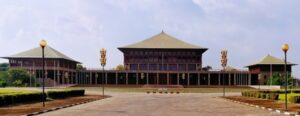
Stabilizing Sri Lanka: President Dissanayake’s Early Steps and Strategic Challenge
- CNL Reporter
- November 16, 2024
- Weekly Political Review
- Wide Angle focuses on political power in fragile economy
- 0 Comments
Weekly Political Review
Wide Angle focuses on political power in fragile economy
By Rohana Jith
Just over two months into his presidency, Anura Kumara Dissanayake took decisive action by dissolving the Parliament and calling for early elections. This bold move resulted in a landslide victory on November 14, securing 159 seats in Parliament.

Yet, with this political success comes the enormous challenge of stabilizing Sri Lanka’s fragile economy.President Anura Kumara Dissanayake faces the formidable task of guiding Sri Lanka through a complex web of economic and geopolitical challenges.
His early actions suggest a willingness to adopt a balanced and inclusive approach, both in domestic policy and international relations.
Stabilizing the economy, managing public expectations, and carefully navigating relationships with major powers will be the core of his administration’s strategy in the months ahead.
How effectively he can execute these strategies will determine not only his political future but also the stability and prosperity of Sri Lanka in the coming years.
Economic Priorities: Immediate Focus on Stability
In the short term, the new government’s primary focus is on stabilizing the economy through debt restructuring, controlling inflation, and generating revenue. Dissanayake’s administration faces a delicate balance between pushing through economic reforms and ensuring social stability.
Success hinges on maintaining public trust and fostering political stability, with a clear understanding that both the global economic climate and international support will be crucial.
The economic crisis has pushed nearly a quarter of the Sri Lankan population into poverty, and Dissanayake’s government has committed to sustainable and inclusive growth.
This means addressing both immediate challenges and laying a foundation for long-term stability. One of his first objectives will be reassuring local and international markets to strengthen investor confidence, essential for the country’s recovery.
Navigating the IMF Bailout and Economic Reforms
During his campaign, Dissanayake highlighted his intention to reassess the terms of the existing IMF bailout while simultaneously advocating for tax reductions. These promises are bold and ambitious, with potential risks if not handled carefully.
Any deviation from the IMF’s recovery plan could jeopardize the next tranche of crucial funding, as warned by former President Ranil Wickremesinghe. Therefore, early and careful negotiations with the IMF and major foreign creditors will be pivotal as Sri Lanka attempts to navigate its most severe economic downturn in decades.
Recalibrating Foreign Policy: A Pragmatic Approach
Dissanayake’s background in the leftist National People’s Power (NPP) party, with its Marxist roots through the Janatha Vimukthi Peramuna (JVP), has led to perceptions of a more pro-China stance.
Under the previous Rajapaksa administration, Chinese investments surged, particularly through the Belt and Road Initiative (BRI), with projects like the Hambantota port symbolizing China’s strong influence. This close economic relationship has raised concerns about Sri Lanka’s debt obligations to Beijing.
In contrast, Dissanayake has shown signs of a more balanced and pragmatic foreign policy. Although he criticized India’s Adani Group’s wind power project during his campaign, citing concerns over energy sovereignty, his initial moves as president suggest a willingness to engage constructively with a range of global powers.
His inaugural address emphasized Sri Lanka’s intent to collaborate with all countries based on national interests, aiming for a flexible, multipolar foreign policy that avoids becoming a pawn between regional giants India and China.
Sri Lanka’s Strategic Role in a Competitive Region
Sri Lanka’s strategic location in the Indian Ocean makes it a critical player in global maritime trade. This geographic advantage means it is central to the interests of regional and global powers, including India, China, and the United States.
While China remains a key economic partner as Sri Lanka’s largest bilateral lender, India’s proactive response to the economic crisis in 2022 strengthened its position as a significant ally. India provided around $4 billion in financial assistance, covering food, medicine, and fuel to stabilize the economy during a dire period.
Dissanayake’s early interactions with India, including meetings with Minister of External Affairs S. Jaishankar and National Security Adviser Ajit Doval, highlight his intent to foster stronger ties.

India’s strategic aid has allowed it to regain a crucial role in Sri Lanka, leveraging historic and geographic ties. Meanwhile, the United States has shown increasing interest in cooperating on various fronts, from economic development to security and climate issues.
For Dissanayake, the challenge will be to maintain a delicate balance between these powerful nations, maximizing economic and strategic gains without compromising Sri Lanka’s sovereignty. As South Asia undergoes political transitions, there is potential for broader regional cooperation, particularly if there is sufficient political will to tackle common challenges.
Debt Management: Negotiating Relief amid High Burden
Sri Lanka’s severe debt crisis has led to recent defaults, and addressing this issue will be a top priority for the new government. Negotiating debt restructuring with international creditors like the IMF, China, and other key lenders will be essential. Achieving favorable terms for debt relief or extensions could stabilize the economy, but delays would risk undermining recovery efforts.
Controlling Inflation and Stabilizing Currency
High inflation has been a persistent problem, eroding the purchasing power of Sri Lankan citizens. Tackling inflation through effective monetary policy and stabilizing the Sri Lankan Rupee will be crucial. Enhancing foreign exchange reserves and improving exports will be necessary steps to regain economic confidence.
Fiscal Reforms and Increasing Revenue
To address the budget deficit without overburdening the population, Dissanayake’s government is expected to focus on comprehensive tax reforms. Enhancing tax efficiency and closing loopholes will be essential in generating revenue while managing public expectations. Spending cuts in certain areas may be inevitable to maintain fiscal discipline.
Ensuring Social Stability and Managing Public Sentiment
Keeping social stability will be critical, especially with the high cost of living. Ensuring access to affordable food, fuel, and other essentials will help maintain public trust. However, if austerity measures become too harsh, there is a risk of public protests, highlighting the need for careful communication and balanced reforms.
Boosting Economic Growth and Employment
Economic revival will require immediate efforts to boost domestic production, particularly in agriculture, small-scale industries, and tourism. These sectors can quickly stimulate growth and create jobs, helping to address the unemployment challenge. Infrastructure and construction projects will also play a vital role in absorbing labor.
Reviving International Relations and Securing Aid
Sri Lanka will need to attract foreign aid and investment, especially from neighboring countries and international financial institutions. Dissanayake’s diplomatic outreach will be key to securing funds that can bolster economic recovery. Additionally, revitalizing the tourism industry, severely impacted by the pandemic and economic downturn, will be crucial in the short term.

